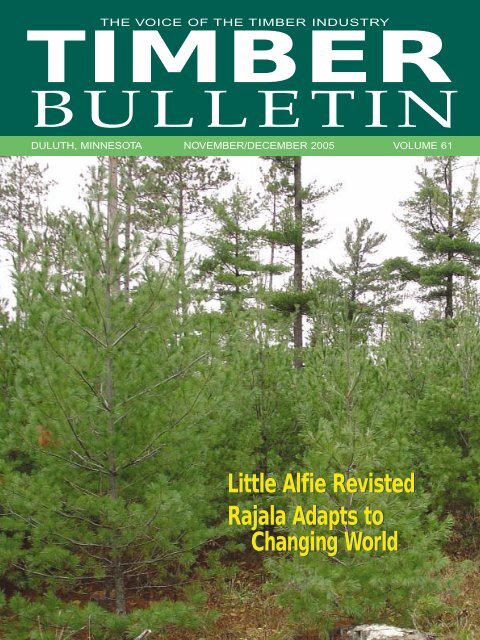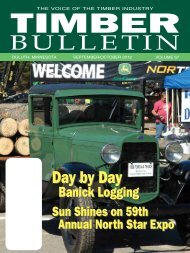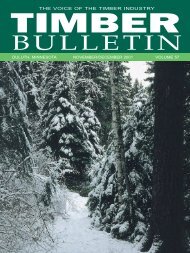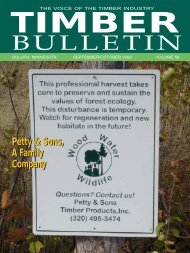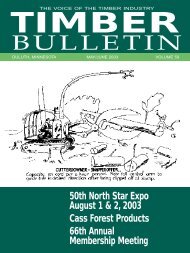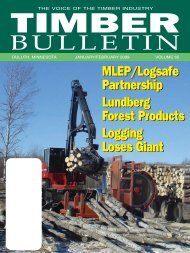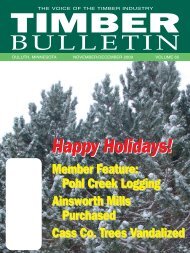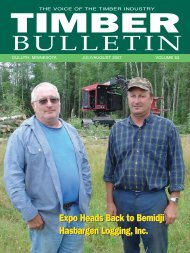Timber Bulletin Nov/Dec - Minnesota Forest Industries
Timber Bulletin Nov/Dec - Minnesota Forest Industries
Timber Bulletin Nov/Dec - Minnesota Forest Industries
Create successful ePaper yourself
Turn your PDF publications into a flip-book with our unique Google optimized e-Paper software.
THE VOICE OF THE TIMBER INDUSTRY<br />
TIMBER<br />
BULLETIN<br />
DULUTH, MINNESOTA NOVEMBER/DECEMBER 2005 VOLUME 61<br />
Little Alfie Revisted<br />
Rajala Adapts to<br />
Changing World
THE VOICE OF THE TIMBER INDUSTRY<br />
TIMBER<br />
BULLETIN<br />
IN THIS ISSUE<br />
Rajala Adapts to Changing World................12<br />
_________________________________________________________________________________<br />
Meet the Director..........................................15<br />
_________________________________________________________________________________<br />
Little Alfie Revisited...................................16<br />
_________________________________________________________________________________<br />
Where are the ATVs to go?...........................20<br />
_________________________________________________________________________________<br />
Loggers of the Past .....................................21<br />
_________________________________________________________________________________<br />
Classifieds....................................................26<br />
_________________________________________________________________________________<br />
Advertisers Index.......................................26<br />
_________________________________________________________________________________<br />
4<br />
12<br />
Volume 61<br />
<strong>Nov</strong>ember/<strong>Dec</strong>ember 2005<br />
Duluth, <strong>Minnesota</strong><br />
TIMBER PRODUCERS<br />
ASSOCIATION<br />
President<br />
DALE ERICKSON<br />
Past President<br />
CLARENCE JOHNSON<br />
1st Vice President<br />
WARREN JOHNSON<br />
2nd Vice President<br />
TOM McCABE<br />
Secretary/Treasurer<br />
MIKE RIEGER<br />
Editor-in-Chief<br />
WAYNE E. BRANDT<br />
Graphic Design, Editorial and Mechanical Production<br />
STEWART-TAYLOR PRINTING<br />
<strong>Minnesota</strong><br />
<strong>Timber</strong> Producers<br />
Association<br />
ON THE COVER<br />
Regenerated white pine at Little Alfie.<br />
Photo was taken at the recent Little<br />
Alfie timber sale.<br />
The <strong>Timber</strong> <strong>Bulletin</strong> is published six times annually,<br />
in February, April, June, August, October and<br />
<strong>Dec</strong>ember by the <strong>Minnesota</strong> <strong>Timber</strong> Producers<br />
Association, located at 903 Medical Arts Bldg.,<br />
324 W. Superior St., Duluth, Minn. <strong>Minnesota</strong><br />
<strong>Timber</strong> Producers Association members receive<br />
the <strong>Timber</strong> <strong>Bulletin</strong> at an annual subscription rate<br />
of $15 which is included in their membership dues.<br />
Periodicals postage paid in Duluth, <strong>Minnesota</strong>.<br />
Advertising rates and data on request. The views<br />
expressed in the <strong>Timber</strong> <strong>Bulletin</strong> do not necessarily<br />
reflect the views or opinions of the <strong>Minnesota</strong><br />
<strong>Timber</strong> Producers Association.<br />
Postmaster: Please send address corrections<br />
to TIMBER BULLETIN, <strong>Minnesota</strong> <strong>Timber</strong><br />
Producers Association, 903 Medical Arts Bldg.,<br />
324 W. Superior St., Duluth, <strong>Minnesota</strong> 55802,<br />
Phone 218-722-5013.<br />
Issn: 10973532 – USPS: 016208<br />
20<br />
24<br />
No articles may be reprinted without written permission<br />
from the <strong>Minnesota</strong> <strong>Timber</strong> Producers Association.<br />
<strong>Timber</strong> <strong>Bulletin</strong> <strong>Nov</strong>ember/<strong>Dec</strong>ember 2005<br />
3
Hello –<br />
First of all, I would like to<br />
extend a warm welcome to Ray<br />
Higgins. Ray is the new MTPA<br />
field representative and brings a<br />
variety of talents that will fit<br />
President’s<br />
Column<br />
nicely<br />
with our<br />
needs.<br />
Welcome,<br />
Ray!<br />
With the<br />
coming of cold<br />
weather, some of<br />
our members<br />
seem to be<br />
having problems<br />
with the mandate<br />
requiring a two<br />
percent biodiesel component in<br />
our diesel fuel. The MTPA staff<br />
has been in contact with the<br />
proper authorities, including the<br />
governor’s office. This is an issue<br />
the state needs to rectify in a<br />
hurry. Every day lost to plugged<br />
filters is very costly to loggers<br />
and the mills. MTPA staff will<br />
continue to monitor this problem<br />
and push for a speedy remedy.<br />
Your calls will help.<br />
The fall round of timber sales is<br />
in progress. I hope everyone was<br />
able to get wood to operate on at<br />
a price they can live with. The<br />
general trend seems to be down<br />
from the unsustainable levels of<br />
the past year. MTPA staff<br />
continues to follow the stumpage<br />
issue and to work with the DNR<br />
on various problems regarding<br />
stumpage.<br />
Finally, the MTPA is on solid<br />
financial footing. The coming<br />
new year and your dues<br />
contributions will continue to<br />
strengthen the association and<br />
enable us to be the strong<br />
advocate that the loggers, small<br />
mills, and landowners need.<br />
Wishing everyone a Merry<br />
Christmas and a Happy New<br />
Year!<br />
Time Inc. Endorses <strong>Minnesota</strong> Logger<br />
Education Program’s New Master Logger<br />
Certification Program<br />
“Today we are qualifying MLEP’s<br />
Master Logger Certification<br />
Program as meeting the<br />
requirements of our CSF (Certified<br />
Sustainable <strong>Forest</strong>ry) program,”<br />
announced David Refkin, director<br />
of sustainable development at<br />
Time Inc.<br />
Recently, Time Inc. endorsed<br />
the <strong>Minnesota</strong> Logger Education<br />
Program’s<br />
(MLEP) Master<br />
Logger<br />
Certification<br />
Program. Logger<br />
certification<br />
promotes sustainable forestry and<br />
provides an independent, thirdparty<br />
audit of a logging business’s<br />
harvest, safety and business<br />
practices. It is a performancebased<br />
program for loggers that<br />
recognizes training, experience and<br />
the implementation of specific<br />
sustainable forest management and<br />
safety practices.<br />
“Today we are qualifying<br />
MLEP’s Master Logger<br />
Certification Program as meeting<br />
the requirements of our CSF<br />
(Certified Sustainable <strong>Forest</strong>ry)<br />
program,” announced David<br />
Refkin, director of sustainable<br />
development at Time Inc. “We look<br />
forward to working with MLEP to<br />
focus on continuous improvement<br />
of the program, similar to<br />
improvements we have seen in<br />
other qualified programs.” Only<br />
two other state logger certification<br />
programs, Wisconsin and Maine,<br />
have received this recognition from<br />
Time. MLEP’s logger certification<br />
program is the only program<br />
qualified by Time Inc. in<br />
<strong>Minnesota</strong>.<br />
“Logger certification provides<br />
confidence to customers and the<br />
public that the person performing a<br />
harvest has the education and<br />
experience to do the job correctly”<br />
said Dave Chura, MLEP’s executive<br />
director. “Certification is an<br />
independent and formal<br />
recognition of those logging<br />
businesses who implement<br />
sustainable forest management<br />
practices and safe, professional<br />
operations.”<br />
Several mills in <strong>Minnesota</strong> and<br />
across the country have been asked<br />
to meet a target that 65 percent of<br />
the resource going into their<br />
product be certified by year-end<br />
2005 and 80 percent by year-end<br />
2006. <strong>Minnesota</strong>’s has 15 million<br />
acres of timberland. Of that 15<br />
million, 38 percent is controlled<br />
by family forest landowners and<br />
these family forests provide 45<br />
percent of the timber harvested<br />
each year.<br />
“Logger certification addresses<br />
this challenge by providing<br />
certified wood from family<br />
forestland to the market place.<br />
This means loggers and mills in<br />
<strong>Minnesota</strong> will be in a strong<br />
position to provide certified wood<br />
from family forestlands to<br />
customers like Time Inc.,” stated<br />
Chura.<br />
MLEP’s Master Logger<br />
Certification Program was<br />
developed by a working group<br />
including representatives from the<br />
<strong>Minnesota</strong> Department of Natural<br />
Resources, The Nature<br />
Conservancy, <strong>Minnesota</strong> <strong>Forest</strong>ry<br />
Association, University of<br />
<strong>Minnesota</strong>, <strong>Minnesota</strong> <strong>Forest</strong><br />
<strong>Industries</strong>, Associated Contract<br />
Loggers and Truckers of <strong>Minnesota</strong>,<br />
<strong>Minnesota</strong> <strong>Timber</strong> Producers<br />
Association, Izaak Walton League<br />
and Dovetail, Inc.<br />
4<br />
<strong>Timber</strong> <strong>Bulletin</strong> <strong>Nov</strong>ember/<strong>Dec</strong>ember 2005
I am very pleased that Ray<br />
Higgins has joined TPA as our new<br />
Field Representative. Ray, a long<br />
time fixture in the Duluth media,<br />
has also been active in the<br />
community with his parish council<br />
and as event coordinator for the<br />
ALS fishing tournament in Duluth.<br />
He’s already been out on a few<br />
logging jobs and will be heading to<br />
more as he learns our industry.<br />
Please join me welcoming Ray to<br />
our team.<br />
<br />
Have you been to the TPA<br />
Annual Meeting in the past few<br />
Executive Vice<br />
President’s<br />
years? Did<br />
it seem a lot<br />
like the last<br />
one you<br />
went to?<br />
Put that out<br />
of your<br />
Column<br />
mind. We are<br />
adopting an<br />
entirely new<br />
format and a new<br />
date for the 2006<br />
annual meeting. It<br />
will be combined<br />
with the annual golf and fishing<br />
outing and a number of new<br />
activities. The dates will be<br />
Thursday, June 8 and Friday June 9<br />
with the meetings being held at<br />
Breezy Point. Mark your calendars<br />
today and look for more<br />
information in the coming months.<br />
<br />
Jelling. And we’re not talking<br />
about shoe inserts. The first several<br />
days of <strong>Dec</strong>ember found the<br />
telephones at the TPA office<br />
ringing off the hook with concerns<br />
about fuel jelling in truck and<br />
equipment filters. We hit this issue<br />
hard right away. Immediate<br />
contacts went to the MN<br />
Department of Commerce and the<br />
Governor’s office. Additionally we<br />
contacted the MN Petroleum<br />
Marketers Association and our<br />
friends in the agriculture lobbies.<br />
Our belief was that the new biodiesel<br />
mandate was causing or<br />
contributing to the problem. As of<br />
the writing of this column we<br />
haven’t tracked it down completely<br />
but we’re on the case.<br />
<br />
The winter logging season looks<br />
like it’s off to a decent start. We’ve<br />
been having some cooler weather<br />
without much snow to keep the<br />
ground from freezing. Winter<br />
weights are being put into effect in<br />
a timely manner. We never know<br />
what the winter will bring but we’ll<br />
keep our fingers crossed that this<br />
year will be as good last winter.<br />
Keeping our fingers crossed is<br />
about as much as we can due about<br />
the weather but it’s not as much as<br />
we can do about safe operations on<br />
the job. Don’t just cross your<br />
fingers when preparing for the toll<br />
that cold weather, longer days and<br />
more days can take on everyone in<br />
the woods or mills. Prepare your<br />
crews now, and every day to work<br />
safely. Don’t just cross your<br />
fingers.<br />
<br />
Little Alfie. Just the name brings<br />
back a lot of memories, both good<br />
and bad. I was heading from our<br />
area meeting in Ely to Orr and<br />
decided to take the Echo Trail. It<br />
was an unusual day because I had<br />
a little extra time. It seemed the<br />
logical thing to do to run down and<br />
take a look at the Little Alfie timber<br />
sale. As the pictures elsewhere in<br />
this issue of the <strong>Timber</strong> <strong>Bulletin</strong><br />
show, the timber sale was a highly<br />
effective silvicultural treatment.<br />
The regeneration was up high<br />
enough that I had to crawl up and<br />
stand on top of my truck to take<br />
some of the pictures.<br />
<br />
If you haven’t been around Ely in<br />
a few years the development will<br />
astound you. Everyone seems to<br />
want their piece of our great<br />
northland. It reminds me of the<br />
discussions we had when the MN<br />
<strong>Forest</strong> Resources Council was<br />
debating the riparian guidelines.<br />
Some of us suggested that debating<br />
whether timber harvesting should<br />
occur in riparian areas was a folly<br />
given the development activities<br />
and pressures on these same lands.<br />
Landowners need to be able to<br />
manage their lands and derive<br />
income from the forest or the<br />
pressures to develop riparian zones<br />
will be even greater. Many folks<br />
agreed with us on this argument<br />
but it was not universal.<br />
<br />
As another year draws to a close<br />
it doesn’t hurt to reflect on the<br />
many blessings that we have all<br />
received in the past year. At TPA<br />
we’ve had our successes and we’ve<br />
had our failures. I am gratified at<br />
the support that our members<br />
provide the organization every<br />
year. 2005 marked an all time<br />
record in dues contributions. This<br />
has allowed us to move forward in<br />
a number of key areas. We’re also<br />
seeing the ongoing transition as<br />
younger loggers and mill<br />
operator’s step forward to provide<br />
the support and leadership<br />
necessary for TPA to continue to be<br />
the voice of the timber industry in<br />
<strong>Minnesota</strong>. One of the great<br />
strengths of TPA has always been<br />
the volunteer leadership of the<br />
organization. It is one of the things<br />
that separates us from other<br />
organizations.<br />
Best wishes for a safe and happy<br />
holiday season.<br />
6<br />
<strong>Timber</strong> <strong>Bulletin</strong> <strong>Nov</strong>ember/<strong>Dec</strong>ember 2005
Mark Your Calendar!<br />
Please mark your calendar for June 8 and 9,<br />
2006, for the TPA Golf and Fishing Outing and<br />
TPA annual meeting at Breezy Point. We’re<br />
combining the two events this year and<br />
preparations are underway to make both bigger<br />
and better than ever. We’ll keep you posted on<br />
our plans in the coming weeks. We look forward<br />
to seeing you at Breezy Point for this exciting<br />
event!<br />
Corrections<br />
In the July/August Meet the Director item it was<br />
incorrectly stated that Katie Kueber started in the<br />
business in 1965. She actually started in 1991 and Two<br />
Inlets Mill is owned by the Kueber family.<br />
The weight of the truck and load in the Guess the<br />
Weight contest at the North Star Expo was incorrectly<br />
published in the September/ October issue.<br />
We apologize for these errors.<br />
<strong>Timber</strong> <strong>Bulletin</strong> <strong>Nov</strong>ember/<strong>Dec</strong>ember 2005<br />
9
UPM Acquires a<br />
Russian Logging<br />
Company<br />
UPM has acquired 99 percent of<br />
the shares of the Russian logging<br />
company ZAO Tikhvinsky<br />
Komplexny Lespromkhoz from 200<br />
private owners. Through this<br />
acquisition, UPM aims to improve<br />
the availability of quality timber to<br />
UPM’s own production plants in<br />
Russia as well as to the company’s<br />
mills in Finland.<br />
ZAO Tikhvinsky Komplexny<br />
Lespromkhoz has a logging license<br />
for almost 200,000 hectares of<br />
forests in Tikhvin municipality,<br />
situated in the eastern part of the<br />
Leningrad province about 250<br />
kilometers east of St. Petersburg.<br />
The company also owns two small<br />
sawmills. The company employs<br />
500 to 700 persons, depending on<br />
the season.<br />
Mr. Juri Vasilievits Orlov will<br />
continue as a managing director of<br />
the company. UPM aims to develop<br />
the know-how of the Tikhvinsky<br />
staff and to improve the efficiency<br />
of the company’s operations. One<br />
part of this is a development<br />
project which will result in forest<br />
management and wood sourcing<br />
practices fulfilling the criteria of the<br />
international forest certification<br />
standards.<br />
For further information, please<br />
contact: Mr. Jaakko Sarantola,<br />
Director, <strong>Forest</strong>ry and Wood<br />
Sourcing, UPM, tel. +358 40 707<br />
0221; Mr. Juhani Hongisto,<br />
Director, <strong>Forest</strong>ry and Wood<br />
Sourcing, Russia, UPM, tel.<br />
+358 40 847 6730 or +7 921 920<br />
8470; Ms. Aili Piironen, Corporate<br />
Communications, tel. +358 204 150<br />
221.<br />
UPM is one of the world’s leading<br />
producers of printing papers and the<br />
clear market leader in magazine<br />
papers. The group’s sales in 2004 were<br />
nearly EUR 10 billion, and it has<br />
33,400 employees. UPM’s main<br />
products include printing papers,<br />
converting materials and wood<br />
products. The company has production<br />
plants in 15 countries and its main<br />
market areas are Europe and North<br />
America. In Russia, the company has a<br />
plywood and veneer mill in Chudovo, a<br />
sawmill in Pestovo, representative<br />
offices both in Moscow and in St.<br />
Petersburg and a wood sourcing<br />
organization in St.Petersburg.<br />
UPM’s shares are listed on the<br />
Helsinki and New York stock<br />
exchanges. Further information is<br />
available on the company’s website at<br />
www.upm-kymmene.com.<br />
10<br />
<strong>Timber</strong> <strong>Bulletin</strong> <strong>Nov</strong>ember/<strong>Dec</strong>ember 2005
Rajala Adapts to Changing World<br />
by Dave Johnson<br />
Reprinted with permission by<br />
Northern Logger and <strong>Timber</strong> Processor<br />
Magazine, Old Forge, New York.<br />
In his 60-plus years, Jack Rajala<br />
has seen hard times and good<br />
times. His grandfather was a<br />
Finnish immigrant who tried to<br />
make it as a farmer on 160 acres in<br />
northern <strong>Minnesota</strong>. Failing that,<br />
he went into the logging and<br />
sawmilling businesses at the time<br />
when the big pines were being<br />
logged off. Not surprisingly, he<br />
went bust a couple of times. Jack<br />
says he's never known a sawmiller<br />
who hasn't had his ups and downs<br />
and he includes himself in that<br />
group. Right now, he and his<br />
company are in a “down,” having<br />
watched their business decline by<br />
two thirds over the past few years.<br />
Rajala is CEO of the company<br />
that includes his brothers and sons<br />
and has its headquarters in Deer<br />
River, Minn. Jack and his son, John,<br />
are open and frank about their<br />
problems. Like most forest<br />
products industries in this area, the<br />
Rajala sawmills depended on a<br />
steady supply of timber from the<br />
Chippewa National <strong>Forest</strong>. This<br />
stopped cold when the forest<br />
produced a new management plan<br />
that curtailed all logging except<br />
some thinning of red pine<br />
plantations. Down went the<br />
sawmill that was sawing 3-4<br />
million board feet a year and<br />
employed 15 people.<br />
Then, the Itasca County<br />
supervisors put the county under<br />
<strong>Forest</strong> Stewardship Council<br />
certification. The plan called for the<br />
prohibition of cutting any large<br />
trees. The Rajalas had two sawmills<br />
that depended on that timber, each<br />
running two shifts. Now they have<br />
one mill that runs one shift. This<br />
also eliminated about 15 jobs and<br />
reduced their lumber output by an<br />
additional three million board feet<br />
per year. These were major blows,<br />
but the family owns about 35,000<br />
acres of forestland, so it was able to<br />
keep going. Currently, the company<br />
operates four sawmills in<br />
<strong>Minnesota</strong> and one in Ontario,<br />
John Rajala outside the company’s<br />
headquarters in Deer River.<br />
Logger visited. Rajala ships lumber<br />
to China in containers. John says<br />
they can ship a full container load<br />
of wood to China cheaper than<br />
they can truck a load of lumber to<br />
Seattle. Overall, 25 percent of the<br />
company's business is exports.<br />
Part of the way Rajala<br />
Companies has survived is by<br />
innovation and branching out into<br />
new markets. The mills have also<br />
become more efficient simply<br />
because it is easier to closely<br />
supervise a small operation than a<br />
large one.<br />
For example, John says that<br />
much of his day is now taken up<br />
ensuring that the mills produce<br />
what they can sell immediately and<br />
only that. He says they can no<br />
longer simply saw up logs and<br />
stack the lumber waiting for a<br />
buyer to come along. He says that<br />
if the mill is sawing 8/4 red pine,<br />
for example, and a special order<br />
comes in for, say 4x4s or 3x16s, he<br />
will order the sawyer to switch to<br />
what is needed and then return to<br />
his regular work. This requires<br />
close communication and flexibility.<br />
This, “produce upon demand”<br />
philosophy is apparent from the<br />
highway. There is about a 40-acre<br />
field full of stacked lumber at the<br />
Deer River mill and all of it is<br />
bright; no “gray inventory” in<br />
sight.<br />
Even though the company<br />
operates in an area that has the<br />
highest unemployment in the state,<br />
running about ten percent, Jack<br />
says that few applications are<br />
submitted for jobs at the sawmill.<br />
He says that not many of the ten<br />
percent are willing – or in some<br />
cases, able – to do sawmill work for<br />
sawmill wages. He says the soughtafter<br />
jobs are in the so called service<br />
industry. These “positions” carry<br />
more prestige and are a lot easier<br />
physically than, for example,<br />
working the green chain in a<br />
sawmill.<br />
While Rajala’s workforce in the<br />
higher-paying, more skilled jobs is<br />
stable and consists mainly of older<br />
workers who have a history with<br />
the company, there is a large<br />
turnover in the lower-paying entrylevel<br />
jobs. John wonders who will<br />
Canada, employing a total of about<br />
160 people in the mills and the<br />
various value-added activities.<br />
The business has moved heavily<br />
into the value-added area, slicing<br />
veneer rather than the more<br />
traditional method of peeling. They<br />
have the process down and they<br />
are producing high-quality veneer,<br />
but John points out that it is barely<br />
breaking even. Much of the<br />
problem with it is marketing. The<br />
veneer market is a very competitive<br />
business, and it’s been difficult for<br />
Rajala to break into it. They can use<br />
sawlogs for this veneer product,<br />
but they also use any veneer grade<br />
logs they buy, rather than selling<br />
them separately as many mills do.<br />
Until recently, furniture<br />
manufacturing was a major<br />
industry in this country and the<br />
Rajalas had a large share of the<br />
market supplying furniture<br />
companies with lumber. Now that<br />
that market has almost vanished<br />
Rajala is shipping lumber that<br />
would have gone to these companies<br />
to China, where most furniture sold<br />
in the United States is now made.<br />
The company used to sell lumber<br />
to European markets but that dried<br />
up when the Berlin Wall came<br />
down. John says there was – and is<br />
– a lot of good hardwood timber in<br />
the former Eastern block countries<br />
that came onto the market with the<br />
end of the cold war.<br />
John had just returned from a<br />
trip to China when The Northern (continued on page 14)<br />
12<br />
<strong>Timber</strong> <strong>Bulletin</strong> <strong>Nov</strong>ember/<strong>Dec</strong>ember 2005
(continued from page 12)<br />
replace these older men when they<br />
retire.<br />
He says that once a mill worker<br />
qualifies for a skilled job, that's<br />
where he will continue to work. He<br />
says they can't just create phony<br />
“supervisory” jobs to promote<br />
good people into as a reward for<br />
good service.<br />
The Rajala family is also in the<br />
logging business with another son<br />
running two Ponsse units. Here the<br />
escalating stumpage prices are a<br />
concern, as they are to the milling<br />
part of the business. Jack says it is<br />
difficult to produce products that<br />
utilize material, the price of which<br />
fluctuates for no apparent reason,<br />
out of control of the producer. He<br />
says that the pulpmills have a<br />
group of preferred suppliers. When<br />
they are desperate, he says, they<br />
give these producers the go-ahead<br />
to pay what they have to in<br />
competitive bidding for stumpage<br />
contracts, and then the difference is<br />
made up by the mill. This makes<br />
stumpage artificially high. Jack<br />
feels this sort of cannibalizing will<br />
have to come to an end sometime,<br />
taking people who are riding high<br />
now down with it.<br />
In northern Wisconsin, cut-tolength<br />
logging systems are being<br />
used successfully for first thinnings<br />
in red pine plantations using an<br />
innovative technique. Historically,<br />
these plantations were thinned<br />
after about 25 years by removing<br />
every other row, thus removing<br />
half of the trees, good and bad<br />
alike. The harvesting techniques,<br />
manual felling and forwarding<br />
with Iron Mule type forwarders,<br />
made this the only practical<br />
approach. It was just accepted that<br />
a lot of potential crop trees were<br />
taken. Later, as more mechanized<br />
Rajala utilizes this LeTourneau yard machine.<br />
The company cuts a lot of 4/4 pine<br />
lumber.<br />
equipment was introduced,<br />
foresters started specifying taking<br />
every third row. That still took a lot<br />
of good trees.<br />
Now, with the long booms and<br />
high cabs on processors, the<br />
operators are able to see and reach<br />
into rows on either side and select<br />
trees for harvest. This has led to<br />
clearing every seventh row and, by<br />
reaching thru, to selectively thin the<br />
six rows in between, three rows on<br />
a side. The trees cut probably<br />
average about three sticks. There is<br />
some question whether the<br />
operator can see well enough to do<br />
a good job of selecting trees and,<br />
maybe most importantly, whether<br />
the logger can make a living using<br />
these machines in this manner. Jack<br />
did some quick calculations. He<br />
feels that, in order to stay<br />
profitable, units such as these must<br />
produce wood worth $600 a day. As<br />
an example, with wood worth $20 a<br />
cord to the logger, each unit must<br />
produce 30 cords a day to come out<br />
ahead. Apparently this is a realistic<br />
number since there are several<br />
operations in Wisconsin that are<br />
reportedly doing well.<br />
As for forest certification, Jack is<br />
not opposed to the idea. He served<br />
on a committee that developed SFI,<br />
but he feels it has so many<br />
“wrinkles” as it now stands it is of<br />
little value. His forests are not<br />
certified. He says that there are<br />
thousands of highly trained<br />
foresters in the U.S. who are doing<br />
a good job managing the nation’s<br />
forests and he sees little need for a<br />
layer of bureaucracy over them. He<br />
says that way before any of this<br />
started, he took his customers out<br />
into the woods and explained what<br />
he was doing. These were generally<br />
not guided tours but hunting and<br />
fishing excursions. He says that, to<br />
a man, they were impressed and<br />
most of them stayed with his<br />
company – some because they<br />
respected good forest management,<br />
others simply because they could<br />
see that, through good<br />
management, they were assured a<br />
supply of wood down the line.<br />
He feels that little is gained by<br />
having outsiders come in and make<br />
rules he must abide by. He doesn't<br />
feel they are extreme<br />
environmentalists, by and large,<br />
but rather people who are out to<br />
make a profit and who often fail to<br />
take local conditions into account.<br />
It seems strange to him that, while<br />
this concept was developed under<br />
Third World conditions where the<br />
needs of indigenous people were<br />
one of the prime considerations,<br />
little or no weight is given by the<br />
people doing the inspections to the<br />
effect that the rules they make have<br />
on the local population in this<br />
country. He cites a nearby town<br />
where there used to be two factories<br />
turning out wood products where<br />
there are now none. He is skeptical<br />
of some of the claims made for<br />
certification. He feels that too often,<br />
being certified is simply an<br />
advertising gimmick that does little<br />
to improve forest management.<br />
Instead of certification under one<br />
of the existing programs, Rajala is<br />
introducing a line of wood<br />
products under the name of “True<br />
North Wood.” The line will<br />
emphasize “North woods beauty,<br />
sustainability and hard working<br />
people.” One goal is to market<br />
flooring from previously ignored<br />
species, such as Tamarack.<br />
Tamarack is a heavily grained<br />
species and it has not been shown<br />
that it will sell well against bland<br />
flooring such as maple.<br />
In 1998, Jack wrote a book,<br />
“Bringing Back the White Pine.” It<br />
14<br />
<strong>Timber</strong> <strong>Bulletin</strong> <strong>Nov</strong>ember/<strong>Dec</strong>ember 2005
documents his efforts in reforestation<br />
on his own acres and<br />
lays out a plan to reintroduce the<br />
white pine to the area where it once<br />
grew but has now been replaced by<br />
lesser species. In the forward he<br />
acknowledges the role his own<br />
ancestors played in bringing that<br />
great forest down and indicates<br />
that he feels a special responsibility<br />
for trying to restore what is now<br />
gone.<br />
It’s not just words with Jack<br />
Rajala. The company has planted<br />
thousands of its own acres with<br />
white pine, planting 250,000 trees<br />
in a single year. He says that some<br />
people feel that it should be easy to<br />
restore the white pine to an area<br />
where it once grew in abundance,<br />
but conditions have changed so<br />
much over the past century that it<br />
requires much effort and patience.<br />
He says that if he is to be<br />
remembered for anything he would<br />
wish it to be for his efforts in<br />
restoring these magnificent trees to<br />
northern <strong>Minnesota</strong>.<br />
The “lumber barons” clearcut<br />
their way across the top of the<br />
United States at around the turn of<br />
the century, eliminating much of<br />
the white pine that grew there.<br />
Many of them ended up on the<br />
West Coast where companies<br />
bearing their names still operate. A<br />
classic case is the company started<br />
by Frederick Weyerhaeuser. He<br />
built his last sawmill in <strong>Minnesota</strong><br />
in 1910. It produced a million board<br />
feet of white pine lumber a day.<br />
Those are production statistics you<br />
don’t see anymore – at least not in<br />
white pine.<br />
The company office sits right on<br />
a main highway and there is a<br />
steady stream of logging trucks<br />
moving on this highway. Jack<br />
notices all of these out of the corner<br />
of his eye. He can tell where the<br />
trucks are coming from and he<br />
tends to evaluate each load as it<br />
passes. He knows where the logs<br />
are going by the type of wood and<br />
the appearance of the trucks.<br />
Hopefully, in the future, more of<br />
these trucks will be pulling into<br />
Rajala sawmills with more lumber<br />
trucks pulling out.<br />
The Rajalas have been thru many<br />
of the trials other companies have<br />
yet to face. These trials are not over<br />
yet, but if the past few years are<br />
any indication, the company is well<br />
positioned to weather the storms.<br />
<strong>Minnesota</strong> <strong>Timber</strong> Producers Association<br />
Meet the Director<br />
Lowell Pittack recently retired<br />
from Pittack Logging, Inc., which<br />
he began in 1979. But his<br />
retirement from business hasn’t<br />
meant a retirement from TPA<br />
Board duties at all. Lowell is<br />
extremely dedicated to the TPA,<br />
serving as chair of the<br />
membership committee. He has<br />
also served on the transportation<br />
and insurance committees, and is<br />
a founding member of MLEP.<br />
Lowell says TPA has<br />
contributed to the success of his<br />
business by providing “a forum<br />
for common interests of loggers.<br />
Membership has reduced<br />
insurance and other operating<br />
costs, provided drug testing<br />
services, and educational<br />
opportunities. TPA also gives<br />
loggers the opportunity to<br />
collectively speak with one voice<br />
in the community and in the<br />
legislature.” Plus, Lowell adds,<br />
it’s a way to make lifelong<br />
friends.<br />
Lowell is also involved in the<br />
Itasca Development Corporation,<br />
the Grand Rapids Chamber of<br />
Commerce <strong>Forest</strong>ry Affairs<br />
Committee, the Blandin Paper<br />
Company Environmental<br />
Advisory Board, and the Blandin<br />
Expansion and Retention<br />
Committee.<br />
He is a Community<br />
Presbyterian Church trustee, and<br />
helps with the University of<br />
<strong>Minnesota</strong> North Central<br />
Endowment Fund.<br />
Lowell and his wife, Judy, have<br />
three children, Sandra, Susan and<br />
L. Scott, and six grandchildren.<br />
Lowell enjoys hunting, fishing,<br />
traveling and working in the<br />
wood shop.<br />
<strong>Timber</strong> <strong>Bulletin</strong> <strong>Nov</strong>ember/<strong>Dec</strong>ember 2005<br />
15
Thick new growth follows the timber sale.<br />
Before and after – the stump is surrounded by vigorous<br />
white pine growth.<br />
Little Alfie<br />
Revisited<br />
Little Alfie. Who can forget that<br />
name? It was one of the epic<br />
battles waged by environmentalists<br />
against timber harvesting in<br />
<strong>Minnesota</strong>. Fortunately for the<br />
forest, the environmentalists lost.<br />
Little Alfie was a timber sale on<br />
the Superior National <strong>Forest</strong><br />
southeast of Orr. It was purchased<br />
by TPA member Cusson Camp<br />
Company (Tony Vukelich) and was<br />
harvested by Gregg Olson.<br />
The environmentalists sued to<br />
halt this timber sale. Ultimately<br />
U.S. District Court Judge Jack<br />
Tunheim ruled that the sale could<br />
go forward.<br />
The silvicultural purpose of the<br />
sale was to naturally propagate<br />
white pine by removing an over<br />
story of red pine pole wood. This<br />
White pine regeneration at Little Alfie.<br />
site had excellent advanced white<br />
pine regeneration in the under<br />
story that needed space, sunlight<br />
and nutrients to grow. And grow<br />
it has.<br />
The pictures that follow show the<br />
site as it looked on a cool October<br />
day of this year. They show the<br />
power of careful, scientific forest<br />
(continued on page 18)<br />
Seedlings become saplings as the forest grows.<br />
New growth on what had been a haul road.<br />
16<br />
<strong>Timber</strong> <strong>Bulletin</strong> <strong>Nov</strong>ember/<strong>Dec</strong>ember 2005
Introducing: TPA Merchandise<br />
Cotton Polo Shirt $23.00<br />
Taupe with Green TPA logo<br />
Men’s Sizes: S-5XL, XLT, 2XLT<br />
Ladies Sizes: S-3XL<br />
Microfiber Wind Shirt $29.50<br />
Taupe with Green TPA Logo<br />
Unisex Sizes: S-5XL, XLT, 2XLT<br />
No Shrink Fleece Crew $21.50<br />
Pine color with cream TPA logo<br />
Unisex Sizes: S- 3XL<br />
Please Fill Out Entire Form:<br />
Name: _____________________________________________<br />
Address: ___________________________________________<br />
City/State/Zip:_______________________________________<br />
Phone Number: ______________________________________<br />
Shipping Address (if different from above):<br />
__________________________________________________<br />
Please Fill out and Include with Check:<br />
Men’s Cotton Polo Shirt: _____Quantity _____ Size<br />
Ladies Cotton Polo Shirt: _____ Quantity _____Size<br />
Windshirt: _____Quantity _____Size<br />
Fleece Crew: ______Quantity _____Size<br />
Checks made out to: TPA Services, Inc.<br />
Add: $3.00 S&H<br />
Total enclosed in check: $___________________<br />
Send Checks Only to TPA Office:<br />
324 West Superior St., Suite 903, Duluth, MN 55802<br />
No Credit Cards or Cash!
(continued from page 16)<br />
management. The white pine have<br />
flourished after the U.S. <strong>Forest</strong><br />
Service’s project and the careful<br />
logging done by Gregg Olson and<br />
his crew.<br />
This is the nicest natural white<br />
pine regeneration that is likely to<br />
be found anywhere in <strong>Minnesota</strong>.<br />
And, it exists because of a timber<br />
sale.<br />
The pictures also demonstrate<br />
the folly of the environmental<br />
litigants and protesters. On the one<br />
hand they pine away for more pine<br />
in our state. In reality, what they<br />
wanted was conflict. The pictures<br />
are truly worth a thousand words<br />
on how to grow more white pine in<br />
this area.<br />
VOL. III<br />
OUT OF PRINT<br />
TPA Announces<br />
New Staff Person<br />
Ray Higgins has joined the TPA<br />
staff as field representative. Ray, a<br />
long-time Duluthian, has spent<br />
over 20 years<br />
working in the<br />
local media. Most<br />
recently he has<br />
been managing<br />
editor at WDIO<br />
TV. Prior to this<br />
he served in<br />
various capacities<br />
for WDIO, KDAL Radio and KDLH<br />
TV in Duluth as well as with KSTP<br />
TV in Minneapolis.<br />
Ray has also been active in the<br />
community, serving as event<br />
coordinator for the ALS Walleye<br />
Tournament in Duluth which has<br />
raised over one million dollars in<br />
the past decade. He has also<br />
served on the ALS board of<br />
directors and on his parish council.<br />
TPA is very pleased that Ray has<br />
joined our team and is looking<br />
forward to the benefits that his<br />
skills and energy will bring to our<br />
members. “The position of field<br />
representative is vital to meeting<br />
the needs of our members and I<br />
know that Ray will do an excellent<br />
job,” said TPA Executive Vice<br />
President Wayne Brandt.<br />
“I am looking forward to<br />
working with all of our members to<br />
help achieve our goals and grow<br />
<strong>Minnesota</strong>’s economy,” Higgins<br />
said.<br />
TIMBER BULLETIN Subscription Order<br />
Please ENTER my subscription to the <strong>Minnesota</strong> <strong>Timber</strong> <strong>Bulletin</strong> (six issues per<br />
year). Payment is enclosed for:<br />
1 year $ 20 2 years $ 35 3 years $ 50<br />
Please type or print clearly.<br />
NAME ____________________________________________________________<br />
ADDRESS _________________________________________________________<br />
CITY _____________________________STATE ____________ZIP____________<br />
COMPANY/ORGANIZATION ____________________________________________<br />
Please send my GIFT SUBSCRIPTION to the <strong>Minnesota</strong> <strong>Timber</strong> <strong>Bulletin</strong> (six issues<br />
per year) to be sent to the name below. Payment is enclosed for:<br />
1 year $ 15 2 years $ 28 3 years $ 40<br />
Please type or print clearly.<br />
NAME ____________________________________________________________<br />
ADDRESS _________________________________________________________<br />
CITY _____________________________STATE ____________ZIP____________<br />
Make checks payable to:<br />
TPA Services, Inc., 903 Medical Arts Bldg., 324 W. Superior St., Duluth, MN 55802<br />
Note: Existing subscriptions will continue at their current rate until they expire.<br />
18<br />
<strong>Timber</strong> <strong>Bulletin</strong> <strong>Nov</strong>ember/<strong>Dec</strong>ember 2005
Where are the ATVs to go?<br />
There are a lot of opinions about<br />
ATV use in the forest. Some view<br />
them as a fine recreational activity.<br />
Others view them as a natural<br />
to be designated, developed and<br />
paid for. And, there needs to be<br />
education and training for riders<br />
and enforcement of laws on bad<br />
actors. Blanket decisions to restrict<br />
ATV use on seemingly appropriate<br />
corridors do not make sense.<br />
resource pariah. One thing is<br />
certain though, ATVs and their<br />
recreational and business use are<br />
here to stay.<br />
Given this, there need to be<br />
places where people can ride<br />
ATVs. As the following pictures<br />
show, this place is not on U.S.<br />
<strong>Forest</strong> Service roads that branch off<br />
of the Echo Trail.<br />
The U.S. <strong>Forest</strong> Service certainly<br />
has its reasons for posting these<br />
roads as closed to ATV use. But<br />
many think that these postings help<br />
drive ATV use onto state, county,<br />
and private roads and lands as well<br />
as into the woods and off of<br />
already developed corridors<br />
themselves.<br />
There will be many more twists<br />
and turns to the ATV debate in<br />
the future. Ultimately areas,<br />
corridors and trails for riding need<br />
20<br />
<strong>Timber</strong> <strong>Bulletin</strong> <strong>Nov</strong>ember/<strong>Dec</strong>ember 2005
LOGGERS OF THE PAST . . .<br />
“Who Logged Here”<br />
by J. C. Ryan<br />
This story is reprinted from an earlier <strong>Timber</strong> <strong>Bulletin</strong>–one of the first of “Buzz”<br />
Ryan’s ever-popular contributions to these pages. The <strong>Bulletin</strong> will continue to<br />
reprint selected stories from the memories he recorded for us.–Editor<br />
(continued on page 23)<br />
<strong>Timber</strong> <strong>Bulletin</strong> <strong>Nov</strong>ember/<strong>Dec</strong>ember 2005<br />
21
(continued from page 21)<br />
<strong>Timber</strong> <strong>Bulletin</strong> <strong>Nov</strong>ember/<strong>Dec</strong>ember 2005<br />
23
24 <strong>Timber</strong> <strong>Bulletin</strong> <strong>Nov</strong>ember/<strong>Dec</strong>ember 2005
<strong>Timber</strong> <strong>Bulletin</strong> <strong>Nov</strong>ember/<strong>Dec</strong>ember 2005<br />
25
Classifieds<br />
To serve our readers better, the <strong>Timber</strong><br />
<strong>Bulletin</strong> offers free classified ads of up<br />
to 85 words to all members and<br />
associate members of the <strong>Minnesota</strong><br />
<strong>Timber</strong> Producers Association. All ads<br />
must be submitted in writing to the<br />
Association office. The MTPA assumes<br />
no responsibility for ad contents and<br />
accepts free ads on a first-come, firstserved<br />
basis within space limitations.<br />
_____________________________________<br />
USED _____________________________________<br />
EQUIPMENT FOR SALE<br />
FOR SALE<br />
CABLE SKIDDERS<br />
1991 JD 640E, new tires ...........35,500<br />
1969 F C4....................................P.O.R.<br />
TJ 240..........................................P.O.R.<br />
TJ 350............................................9,500<br />
1970 JD 440A.............................10,500<br />
640 JD, rebuilt eng. & tran. .....14,500<br />
GRAPPLE SKIDDERS<br />
1991 TJ 450B, Cummins eng...18,000<br />
1982 JD 540B w/studded<br />
chains .....................................21,000<br />
1984 JD 540B,<br />
w/28.1x26 tires.....................23,000<br />
1998 JD 648G II, single function,<br />
enc. cab with A/C................55,000<br />
1998 JD 648G dual function,<br />
DW648GX564653..................P.O.R.<br />
2001 JD 648GIII, single function,<br />
new 28.1x26 tires ..................96,000<br />
2001 JD 648GIII<br />
dual function.......................102,000<br />
2003 JD 648GIII, dual func......P.O.R.<br />
1998 525 Cat, single func.,<br />
winch......................................P.O.R.<br />
1980 TF C6, with 23.1x26 tires..9,000<br />
CRAWLERS<br />
1997 D5MLGP...........................P.O.R.<br />
1975 450C, 6-way blade...........12,500<br />
1990 650G, 6-way blade...........32,000<br />
1977 D6D LGP ..........................27,000<br />
1987 D4H LGP, 6-way blade,<br />
encl. cab .................................27,000<br />
KNUCKLE BOOM LOADERS<br />
1993 Barko 160A, 4 cyl.<br />
Cummins, mounted on<br />
tandem truck, low hrs. ........24,000<br />
1994 Barko 160B, self-propelled<br />
carrier, 60" slasher ................43,000<br />
1998 Barko 160D, 6 cyl.<br />
Cummins, mounted<br />
on trailer ................................44,000<br />
1998 210E Prentice....................45,000<br />
1987 210C 6 cyl JD<br />
slasher pkg ............................27,000<br />
1995 1000B Morbark self-prop.<br />
carrier, pull thru delimber,<br />
60" circular slasher ...............55,000<br />
1987 XL 175 Husky, on truck..17,500<br />
EXCAVATORS<br />
1990 JD 490D.............................24,000<br />
1990 JD 590D .............................P.O.R.<br />
1996 Yanmar B6U mini<br />
excavator ...............................13,750<br />
DELIMBERS<br />
1997 230LC Hyundai<br />
w/3500 DM Denharco.........85,000<br />
Siiro delimber/slasher...............7,000<br />
TRUCKS<br />
1978 GMC 2-ton w/hydr hoist,<br />
flatbed dump ........................ 4,500<br />
FELLER-BUNCHERS<br />
AND SHEARS<br />
775A Barko ................................P.O.R.<br />
2004 570 Hydro-Ax, 1,800 hrs.,<br />
22" sawhead ........................142,000<br />
2000 Tigercat 270C,<br />
low hours.............................105,000<br />
1979 Drott 40, shearhead.........17,000<br />
1978 Drott 40, JD eng...............13,000<br />
1997 JD 843G w/20"<br />
Cameco sawhead .................78,000<br />
1993 JD 590D w/18’<br />
Roto saw ................................27,000<br />
1993 Risley Black Magic<br />
w/Risley sawhead ...............65,000<br />
1998 JD 653E, reconditioned,<br />
very nice, low hours ..........113,000<br />
1976 JD 544B .............................17,000<br />
1976 JD 544, 20" shear..............21,000<br />
1984 JD 544C, 20" shear<br />
w/bucket, new eng..............23,000<br />
1988 910 Cat, 17" shearhead,<br />
rebuilt trans...........................32,000<br />
1984 411B Hydro-Ax................15,000<br />
1987 411B Hydro-Ax................20,000<br />
1986 511B Hydro-Ax, 6 BT<br />
Cummins...............................27,000<br />
1984 Franklin 170 w/28"<br />
Timbco bar saw ....................25,000<br />
WHEEL LOADERS<br />
JD 410 Backhoe, cab.................13,000<br />
1979 JD 544B .............................18,500<br />
1984 JD 544C, new JD eng. .....23,000<br />
1981 JD 644C .............................25,000<br />
MISCELLANEOUS<br />
1988 534B Gradall, 8,000 lb.<br />
lift............................................24,000<br />
1991 853 Bobcat, w/forks<br />
and broom ...............................8,500<br />
1999 ASV Posi-track skidsteer,<br />
rubber tracks.........................21,000<br />
1979 731 Bobcat skidsteer<br />
loader .......................................6,700<br />
Cat V80D 8,000# forklift ...........6,500<br />
60" slasher w/power unit.......14,500<br />
20" Koehring sawhead<br />
to fit 643 JD .............................9,000<br />
New Hanfab slashers,<br />
one 60", one 72".....................P.O.R.<br />
Gafner Iron Mule Prehauler ...12,000<br />
WE ARE A NEW DEALER FOR<br />
BARKO HYDRAULICS<br />
We have other equipment not listed.<br />
New and used parts,<br />
new and used tires and chains.<br />
Something you’re looking for?<br />
Give us a call. We may have it or<br />
be able to locate it for you!!!<br />
We are distributors for<br />
Aftermarket Parts, Rud Chains,<br />
Hanfab Slashers and<br />
Babac Traction Products<br />
NORTHERN TIMBERLINE<br />
EQUIPMENT, INC.<br />
6000 County Road 8<br />
Littlefork, Minn. 56653-9132<br />
Phone 218-278-6203<br />
nte1@frontiernet.net<br />
Fax 218-278-6716<br />
Richard or Cam Hardwig<br />
_____________________________________<br />
ADVERTISERS INDEX<br />
AgStar..............................................................................7<br />
American Interstate Insurance ....................................5<br />
Cass <strong>Forest</strong> Products .....................................................6<br />
Corporate 4...................................................................10<br />
Don Evans Insurance Agency....................................11<br />
Fryberger, Buchanan, Smith & Frederick, P.A.........19<br />
Great Lakes Trailers.....................................................22<br />
Greater Insurance Service...........................................20<br />
Hedstrom Lumber Co.................................................19<br />
Industrial Lubricant.....................................................11<br />
Itasca Greenhouse..........................................................5<br />
LM Products .................................................................13<br />
Lumbermen's Underwriting Alliance.........................9<br />
Northern Engine & Supply ........................................19<br />
Northern <strong>Timber</strong>line Equipment ..............................22<br />
Nortrax ..........................................................................27<br />
Otis-Magie Insurance Agency ...................................15<br />
Pomp’s Tire...................................................................13<br />
Rapids Hydraulic...........................................................9<br />
Rice Blacksmith Saw & Machine.................................2<br />
Road Machinery & Supplies ......................................28<br />
Rux Strapping ..............................................................26<br />
Schaefer Enterprises ......................................................4<br />
Wausau Sales Corp......................................................10<br />
26 <strong>Timber</strong> <strong>Bulletin</strong> <strong>Nov</strong>ember/<strong>Dec</strong>ember 2005


